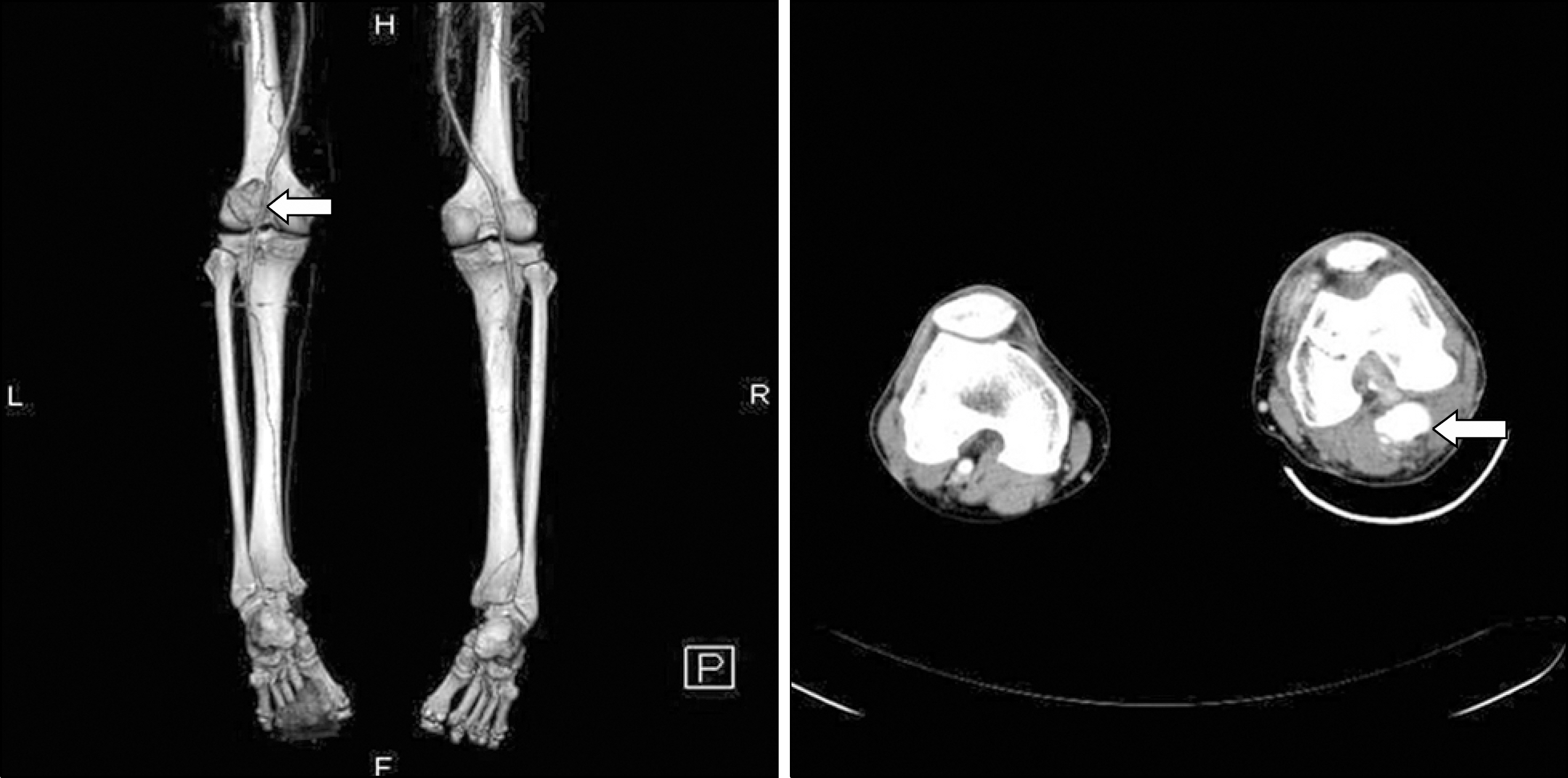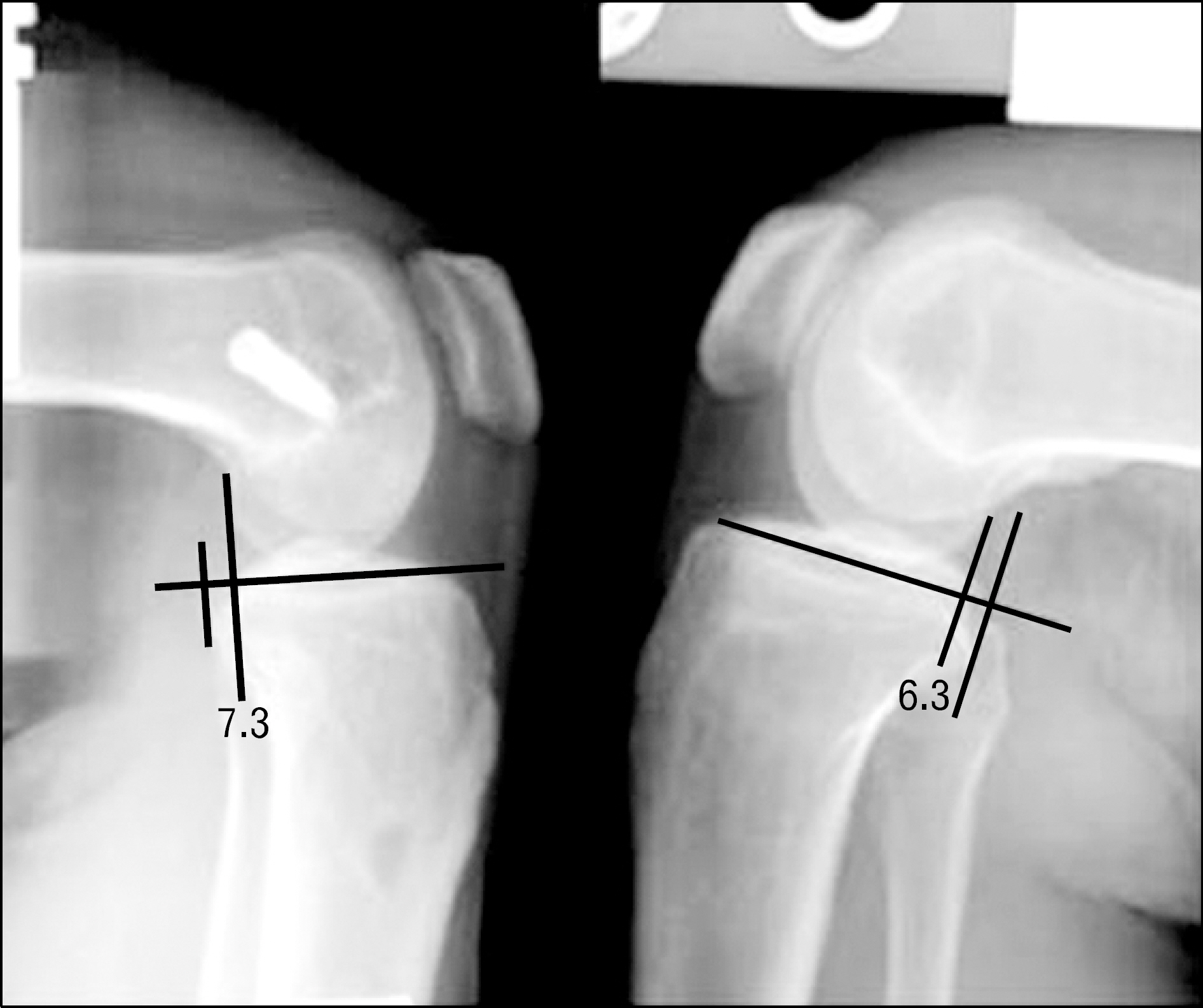Korean J Sports Med.
2011 Jun;29(1):72-75. 10.5763/kjsm.2011.29.1.72.
Popliteal Artery Pseudoaneurysm after Arthroscopic Posterior Cruciate Ligament Reconstruction: A Case Report
- Affiliations
-
- 1Department of Orthopaedic Surgery, Wonkwang University School of Medicine, Iksan, Korea. yjkim1@wonkwang.ac.kr
- KMID: 2054012
- DOI: http://doi.org/10.5763/kjsm.2011.29.1.72
Abstract
- The pseudoaneurysm of the popliteal artery following an arthroscopic posterior cruciate ligament reconstruction is rare. We present a case of the delayed pseudoaneurysm of the popliteal artery after arthroscopic posterior cruciate ligament reconstruction. Open excision of the pseudoaneurysm and pin-point repair were done. Retrospectively reviewing the case, we found that the relation of the popliteal artery and posterior cruciate ligament on preoperative magnetic resonance images can predict the complication of pseudoaneurysm of the popliteal artery.
MeSH Terms
Figure
Reference
-
References
1. Kim TK, Savino RM, McFarland EG, Cosgarea AJ. Neurovascular complications of knee arthroscopy. Am J Sports Med. 2002; 30:619–29.
Article2. Complications in arthroscopy: the knee and other joints. Committee on Complications of the Arthroscopy Association of North America. Arthroscopy. 1986; 2:253–8.3. Complications of arthroscopy and arthroscopic surgery: results of a national survey. Committee on Complications of Arthroscopy Association of North America. Arthroscopy. 1985; 1:214–20.4. Colborn GL, Lumsden AB, Taylor BS, Skandalakis JE. The surgical anatomy of the popliteal artery. Am Surg. 1994; 60:238–46.5. Ninomiya JT, Dean JC, Goldberg VM. Injury to the popliteal artery and its anatomic location in total knee arthroplasty. J Arthroplasty. 1999; 14:803–9.
Article6. Matava MJ, Sethi NS, Totty WG. Proximity of the posterior cruciate ligament insertion to the popliteal artery as a function of the knee flexion angle: implications for posterior cruciate ligament reconstruction. Arthroscopy. 2000; 16:796–804.7. Kim YJ, Kim TK, Yang HD, Kim HJ, Shim SW. Anatomic localization of neurovascular bundle at the level of the Korean knee joint: a magnetic resonance imaging study year. J Korean Arthrosc Soc. 2008; 12:102–6.8. Post WR, King SS. Neurovascular risk of bicortical tibial drilling for screw and spiked washer fixation of soft-tissue anterior cruciate ligament graft. Arthroscopy. 2001; 17:244–7.
Article9. Makino A, Costa-Paz M, Aponte-Tinao L, Ayerza MA, Muscolo DL. Popliteal artery laceration during arthroscopic posterior cruciate ligament reconstruction. Arthroscopy. 2005; 21:1396.
Article10. Jackson DW, Proctor CS, Simon TM. Arthroscopic assisted PCL reconstruction: a technical note on potential neuro-vascular injury related to drill bit configuration. Arthroscopy. 1993; 9:224–7.
Article11. Shiomi J, Takahashi T, Imazato S, Yamamoto H. Flexion of the knee increases the distance between the popliteal artery and the proximal tibia: MRI measurements in 15 volunteers. Acta Orthop Scand. 2001; 72:626–8.
Article
- Full Text Links
- Actions
-
Cited
- CITED
-
- Close
- Share
- Similar articles
-
- Popliteal Pseudoaneurysm after Arthroscopic Posterior Cruciate Ligament Reconstruction
- Compression of the Popliteal Artery after Posterior Cruciate Ligament Reconstruction Using the Tibial Inlay Technique
- Arthroscopic Electrocautery Treatment for Pseudoaneurysm of Inferomedial Genicular Artery after Arthroscopic Anterior Cruciate Ligament Reconstruction and High Tibial Osteotomy
- Popliteal Artery Pseudoaneurysm after Anterior Cruciate Ligament Re-Revision Using a Rigidfix Cross Pin
- Symptomatic Mid-Substance Posterior Cruciate Ligament Calcification of the Knee Joint




